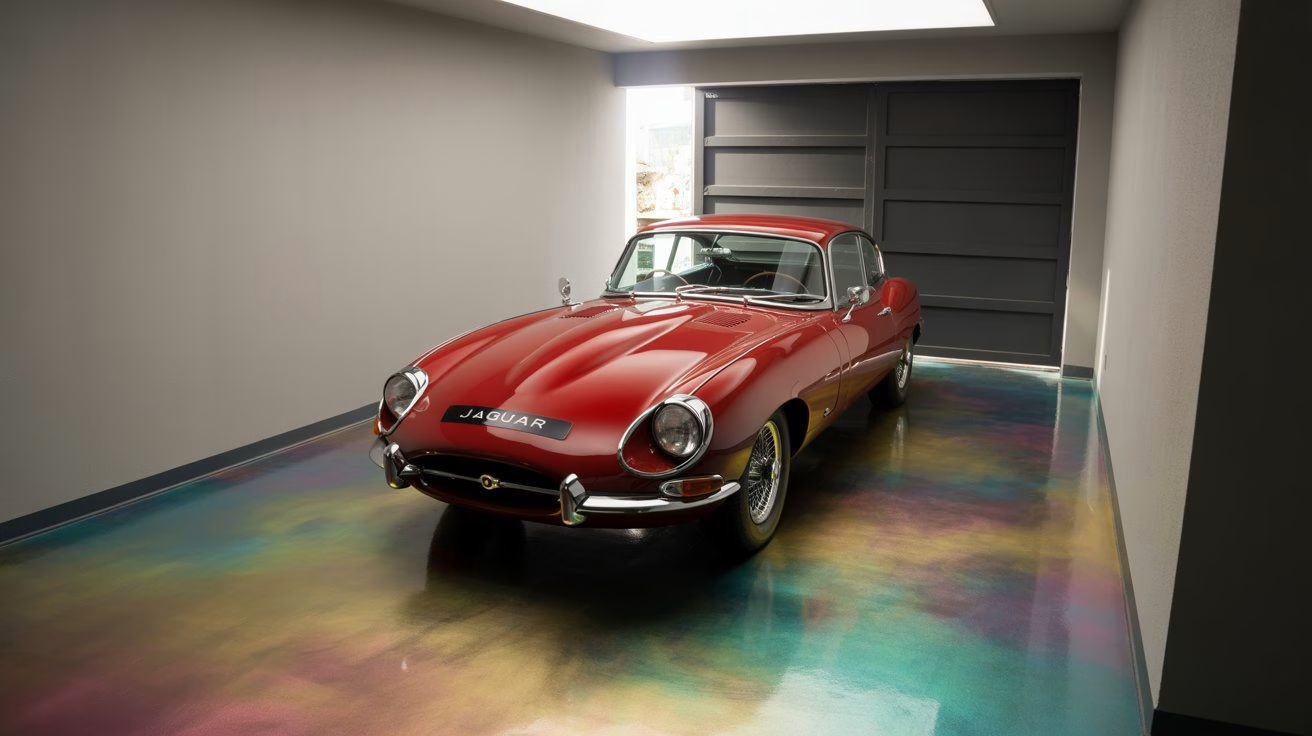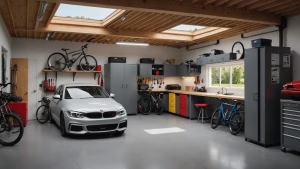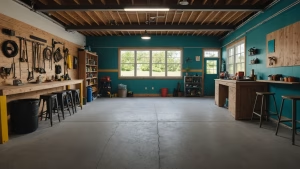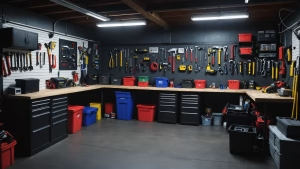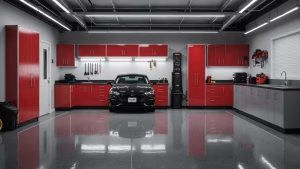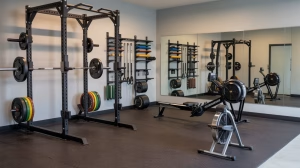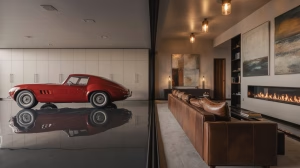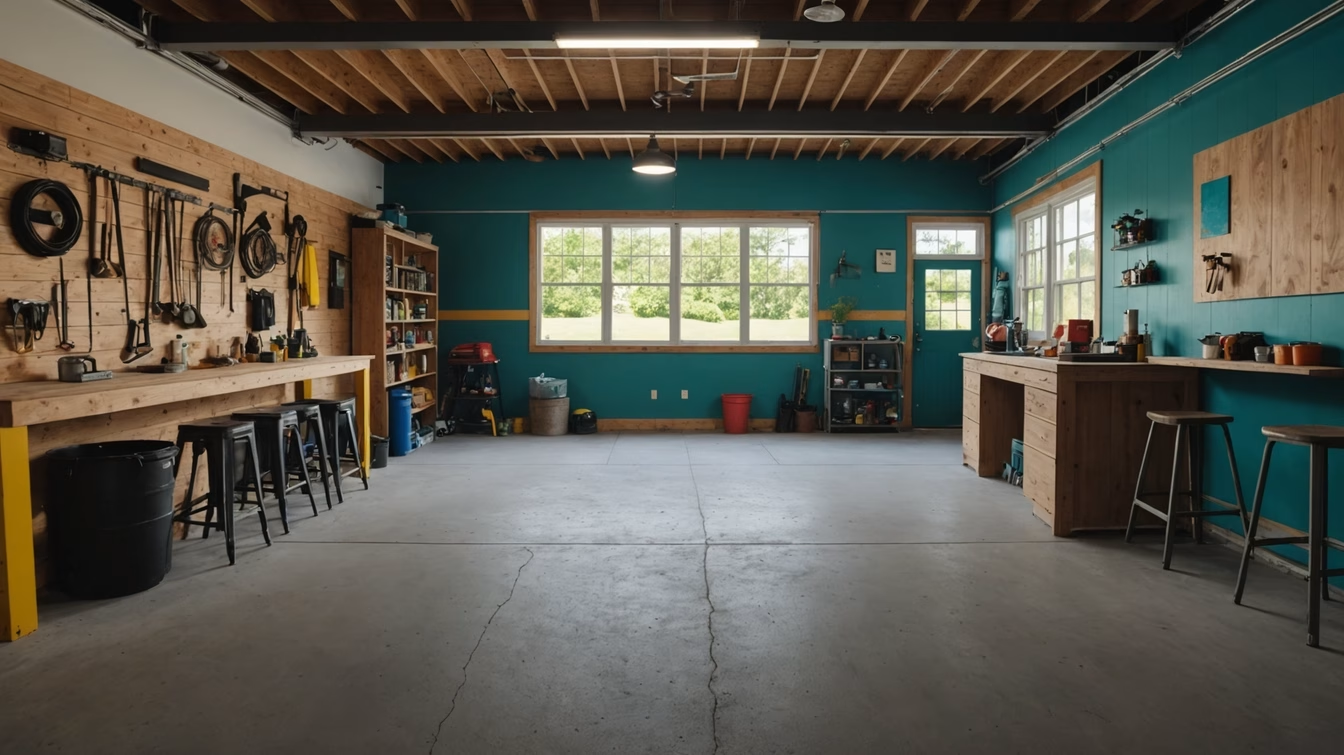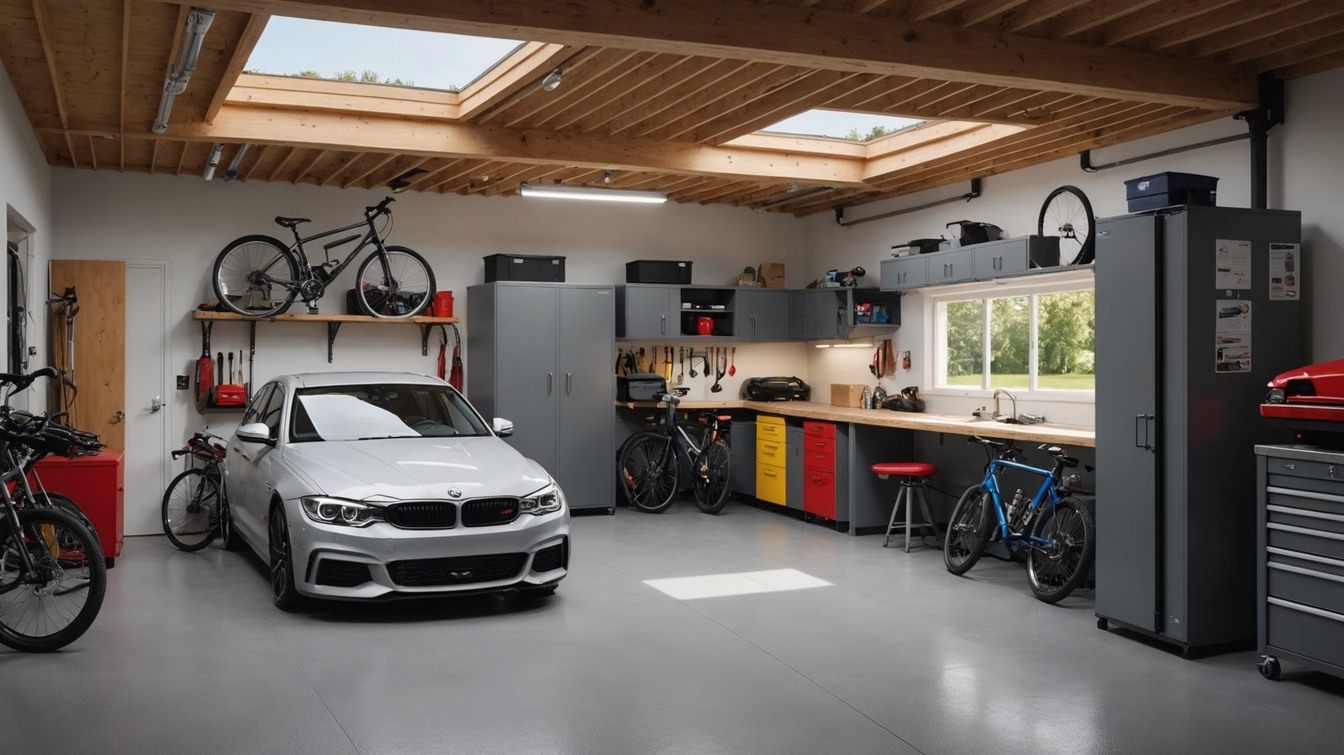1. Bold Solid Colors: A Statement of Simplicity
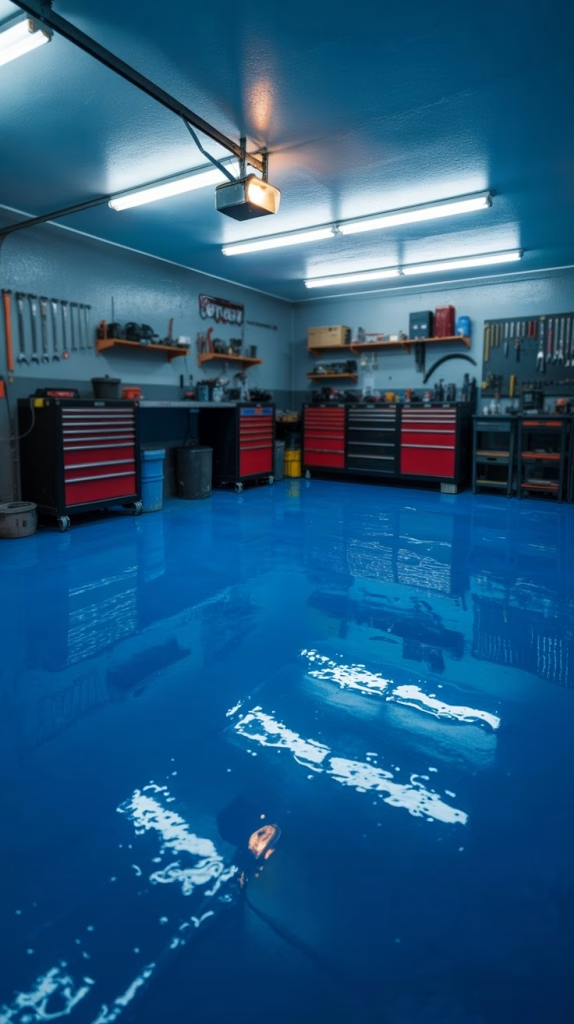
For those who believe that less is more, a bold, solid-colored garage floor can be a powerful design statement. It’s an effective way to inject personality and energy into a space that is often overlooked. Moving beyond the traditional grays and tans, a solid color like a deep forest green, a high-octane yellow, or a sophisticated burgundy can completely redefine the mood of your garage. This approach works particularly well in garages used for more than just parking a car—think of a home gym, a workshop, or a personal studio. The uniform color creates a clean, intentional look that makes the space feel bigger and more cohesive. It can also serve as a striking backdrop for a prized vehicle, making it pop against the monochromatic surface.
When selecting a solid color, consider the overall palette of your home’s exterior and interior. A cohesive color scheme can create a seamless transition from your living space to your garage. For instance, if your front door is a deep red, a similar shade on your garage floor can tie the entire property together. The key to a solid-color floor’s success lies in the quality of the coating and the meticulous preparation of the concrete surface. Imperfections will be more noticeable on a uniform, high-gloss finish, so it is crucial to ensure the concrete is properly cleaned, repaired, and primed before application.
2. Decorative Flake Systems: Texture and Durability
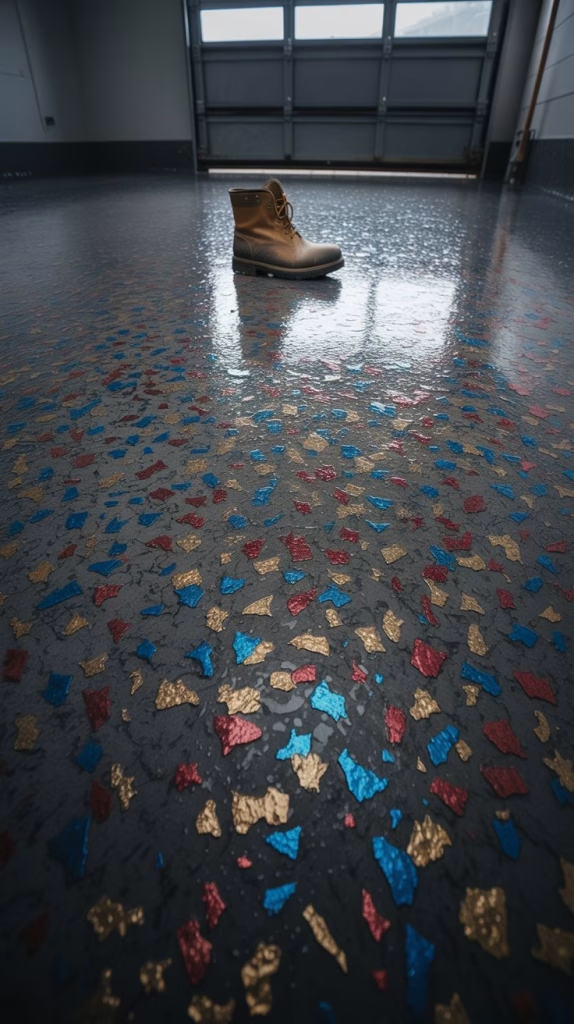
Decorative flake systems are arguably the most popular choice for homeowners seeking a colorful and durable garage floor. This method involves broadcasting colored vinyl flakes onto a wet epoxy or polyaspartic base coat, which are then sealed with a clear topcoat. The result is a floor that is not only visually stunning but also highly functional. The flakes serve a dual purpose: they provide an endless array of color combinations and patterns, and they add texture to the surface, which improves traction and hides minor imperfections. The sheer variety of flake colors and sizes means you can create a floor that is completely unique, from a subtle, sophisticated blend to a bold, confetti-like explosion.
The durability of a flake system is one of its biggest selling points. The combination of a strong polymer base and a protective clear coat makes the floor resistant to hot-tire pickup, chemicals, oil, and abrasions. This makes it an ideal choice for high-traffic garages. The flakes themselves also help to conceal dirt, dust, and tire marks, making maintenance a breeze. When planning a flake floor, you can select from pre-mixed blends or create a custom combination. For a classic, high-end look, consider a blend of black, white, and gray flakes. For a more playful and personal touch, choose flakes in your favorite team’s colors or shades that complement your car.
3. Metallic Epoxy Floors: A Liquid Art Form
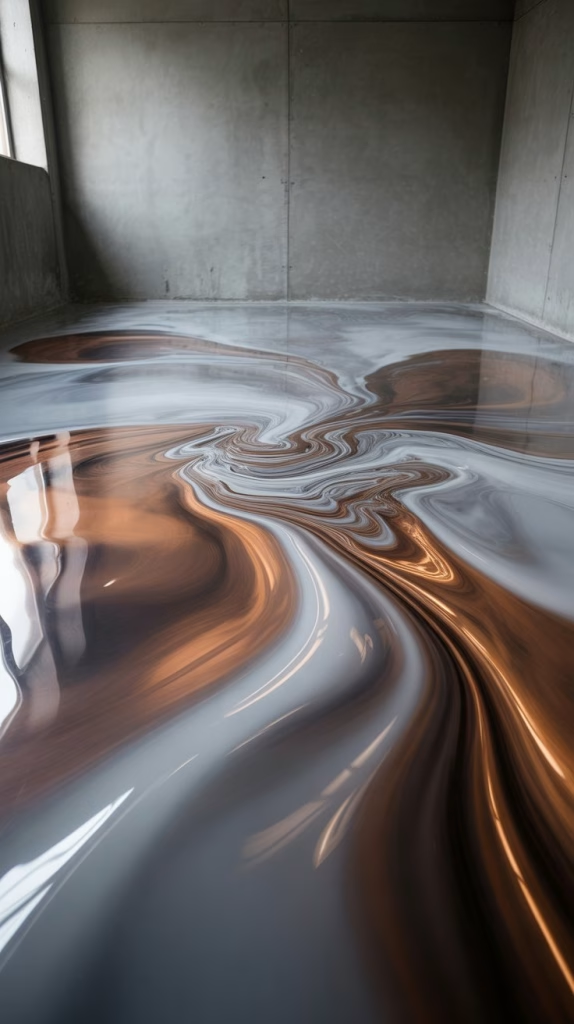
Metallic epoxy is the ultimate choice for the homeowner who wants a garage floor that is truly one-of-a-kind. Unlike other coatings, metallic epoxy uses a special pigment that creates a shimmering, fluid, and pearlescent effect. The pigments are suspended in the epoxy resin and, when agitated, create stunning, multi-dimensional patterns that resemble flowing water, marble, or metallic streaks. No two metallic floors are ever exactly alike, making this a highly customized and unique option. The final look is often described as “liquid art” because of its mesmerizing and organic appearance.
While the aesthetic appeal is undeniable, metallic epoxy floors also offer the same robust protection as traditional epoxy. They are highly resistant to stains, chemicals, and abrasions, making them a practical choice for a working garage. However, due to the complex application process, a professionally installed metallic epoxy floor is essential to achieve the desired effect. The installer must be skilled in manipulating the pigments to create the desired flow and pattern. This is not a project for the inexperienced DIYer. The result is a high-gloss, ultra-modern surface that is both a functional floor and a stunning visual centerpiece.
4. Checkerboard Patterns: A Timeless Classic with a Twist
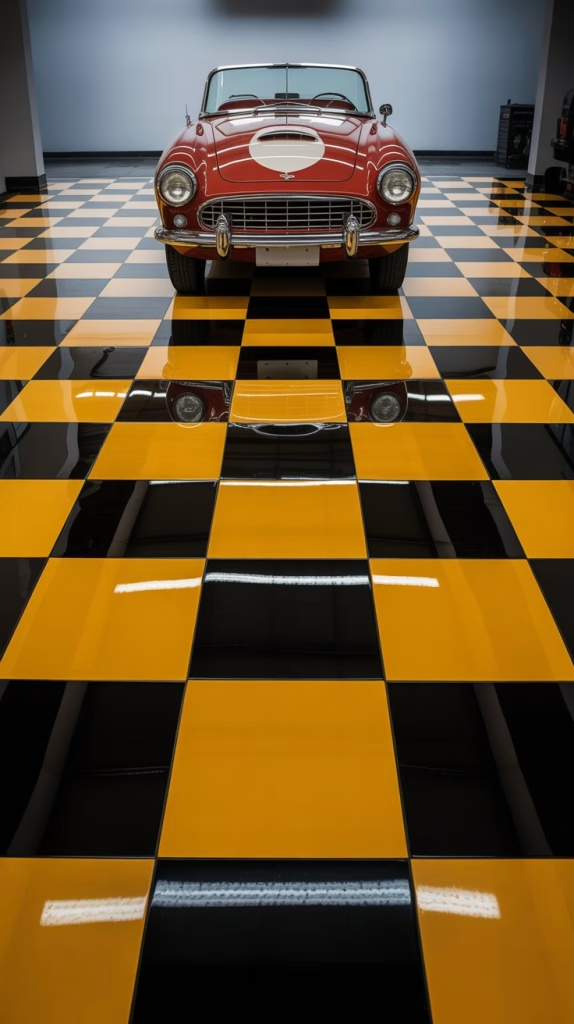
The checkerboard pattern is a classic for a reason. It’s a clean, graphic design that has been a staple in garages and workshops for decades. However, a modern checkerboard floor doesn’t have to be just black and white. By incorporating vibrant colors, you can give this classic pattern a contemporary and personal twist. Imagine a floor with alternating squares of cobalt blue and pure white, or a more subtle, earthy combination of slate gray and terra cotta. This pattern is particularly effective at making a space feel larger and more organized.
Creating a checkerboard pattern can be achieved with a few different materials, including epoxy, garage floor tiles, or even concrete paint. Each method has its own benefits. Epoxy provides a seamless, durable finish, while interlocking tiles offer a flexible, DIY-friendly option that can be easily repaired or replaced. Regardless of the material, a high-quality checkerboard pattern requires careful planning and precise execution to ensure the lines are straight and the squares are uniform. The result is a floor that is both a nod to the past and a bold step into the present.
5. Custom Logos and Inlays: Personalize Your Space
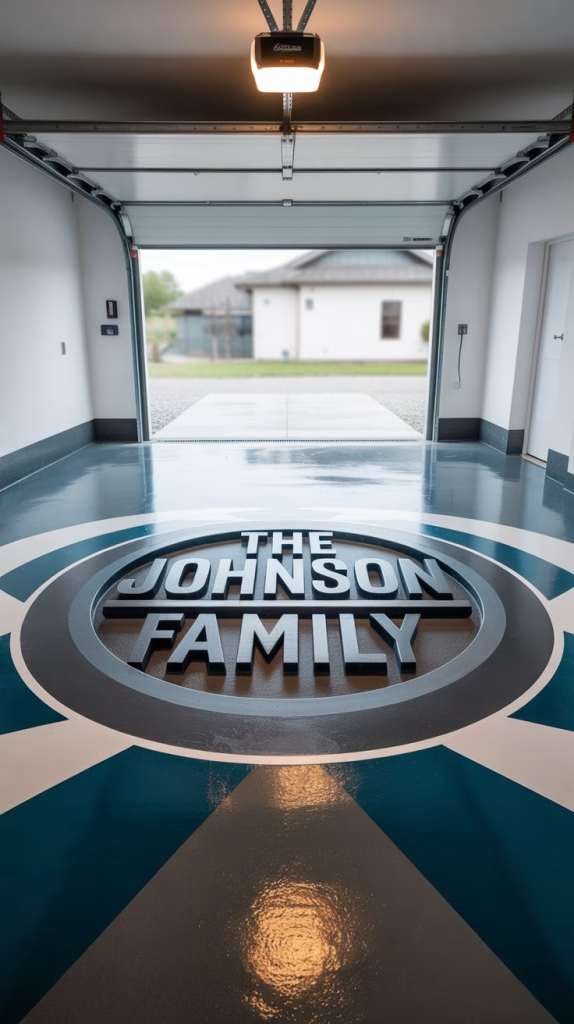
For the ultimate in personalization, consider incorporating custom logos or designs directly into your garage floor. This is a powerful way to transform a standard garage into a truly bespoke space that reflects your hobbies, interests, or even your family’s heritage. Whether it’s the logo of your favorite sports team, the emblem of a cherished car brand, or a personal monogram, a custom inlay turns your garage floor into a canvas for self-expression.
The most common method for creating a custom logo is by using a multi-step epoxy or polyaspartic coating process. The logo is typically a pre-cut stencil or a specially designed decal that is placed on the base coat before the final clear coat is applied. This process requires a professional installer to ensure the logo is perfectly aligned and that the clear coat seals it without any bubbles or imperfections. The finished product is a high-durability floor with a unique and personal touch that will last for years.
6. Color-Blocked Sections: Define Zones with Color
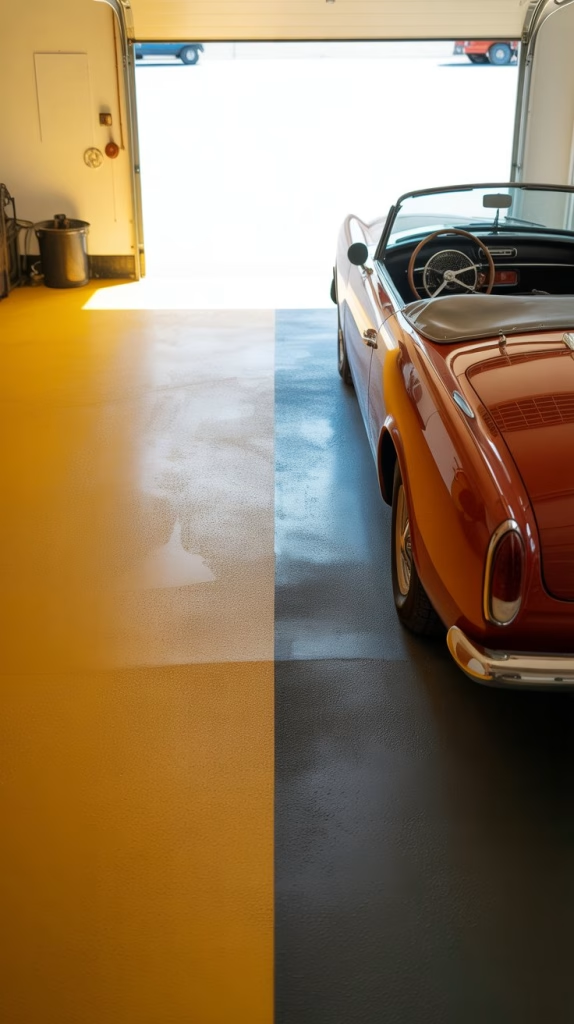
Color blocking is a modern and practical design technique that uses different colors to delineate separate zones within a single space. In a garage, this can be incredibly useful for organizing a multi-functional area. You can use a different color for the workshop area, the parking spot, or a designated “lounge” area. This not only adds a vibrant splash of color but also helps with organization and efficiency. For example, a bright, reflective color in the workshop area can improve visibility, while a darker color in the parking area can better hide oil and grease stains.
To achieve this look, you can use either a solid-color epoxy or polyaspartic coating, or even a combination of a solid color and a decorative flake system. The key is to use high-quality painter’s tape to create clean, sharp lines between the different color sections. It’s a simple but effective way to add both visual interest and practical functionality to your garage floor.
7. Terrazzo-Style Floors: A Retro Resurgence
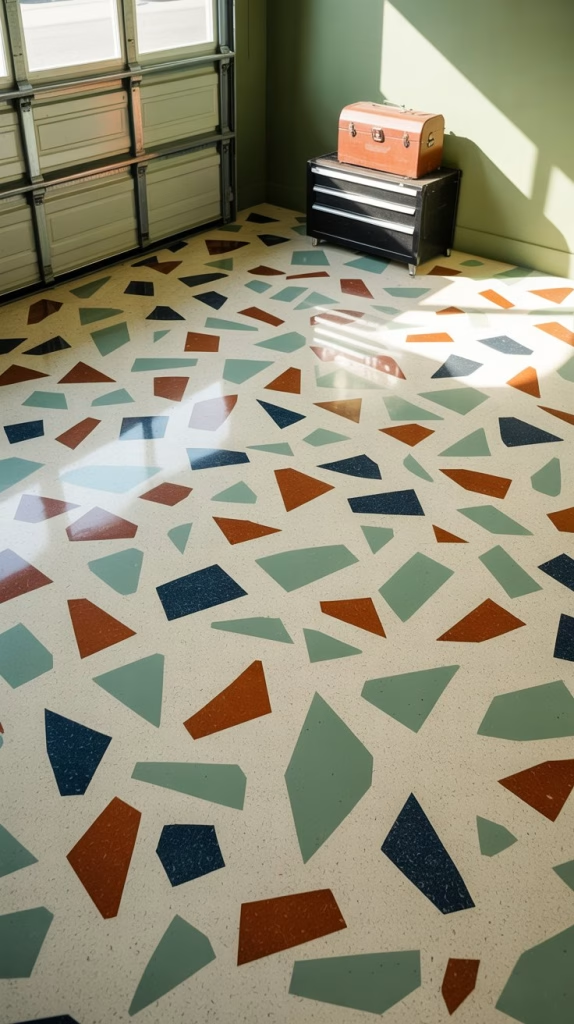
Terrazzo is a classic flooring material known for its speckled, mosaic-like appearance. You can achieve a similar aesthetic in your garage by using a decorative flake system with larger, irregularly shaped flakes. Instead of the small, uniform chips, you can choose a blend of larger, multi-colored flakes to create a more organic, terrazzo-inspired look. This is a great way to incorporate a sense of nostalgia and high-end design into your garage.
The beauty of a terrazzo-style garage floor is its ability to be both visually complex and highly practical. The dense pattern of flakes effectively hides dirt and minor scuffs, and the durable polyaspartic or epoxy coating ensures it can withstand the rigors of a working garage. When choosing your colors, you can opt for a classic, earthy palette or go for a bold, vibrant mix to create a truly personalized and eye-catching floor.
8. Stained Concrete: Translucent Hues with Natural Character
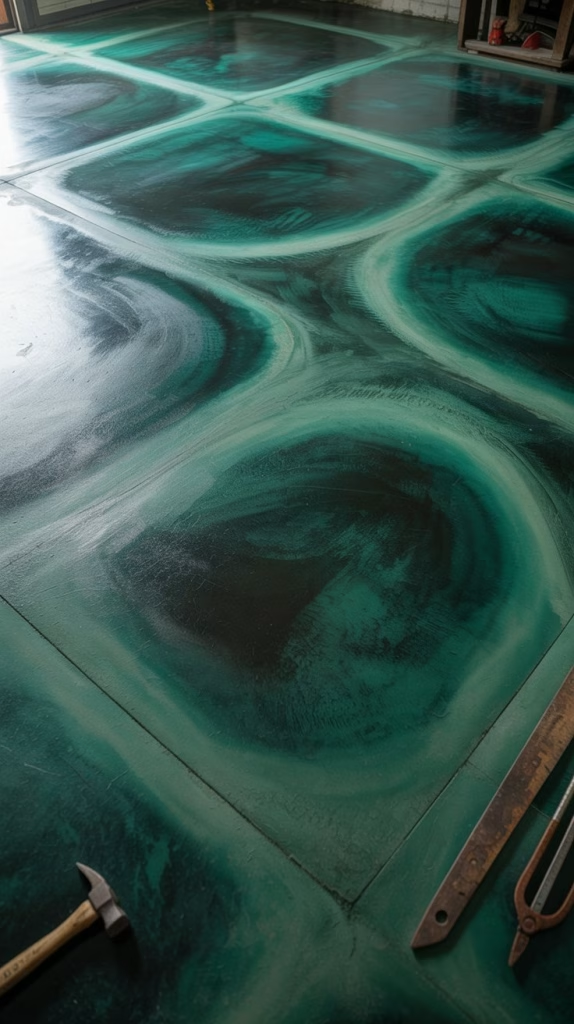
For those who appreciate the raw, industrial beauty of concrete but want to add a splash of color, a concrete stain is an excellent option. Unlike a paint or a coating that sits on top of the concrete, a stain penetrates the surface, creating a translucent, colorized effect. The final color is a result of the chemical reaction between the stain and the concrete, which means that every floor will be unique. Stains come in a wide range of colors, from earthy browns and grays to vibrant shades of blue, green, and red.
A stained concrete floor provides a durable, low-maintenance finish that won’t chip, peel, or flake. However, it’s important to note that a stain offers minimal protection against spills and abrasions on its own. It is highly recommended to apply a high-quality clear sealer over the stain to protect the surface from hot-tire pickup, oil, and other chemicals. The final result is a floor that retains the authentic character of concrete while being infused with a rich and personal hue.
9. Interlocking Tiles: A Flexible and Colorful Solution

If you are looking for a colorful solution that doesn’t involve a complex liquid application, interlocking floor tiles are a fantastic option. These tiles are made from durable materials like PVC or polypropylene and are designed to withstand the weight of vehicles, spills, and heavy foot traffic. They come in a wide variety of colors, allowing you to create custom patterns, checkerboards, or even graphic designs.
The major benefit of interlocking tiles is their flexibility and ease of installation. They can be laid directly over an existing concrete floor without the need for extensive preparation. If a tile becomes damaged, it can be easily removed and replaced. This makes them a great choice for renters or for anyone who wants a colorful, durable floor without the commitment of a permanent coating. They also provide a cushioned, comfortable surface to walk on and can be easily disassembled and moved if needed.
10. Abstract and Swirled Patterns: Artistic Expression on the Floor
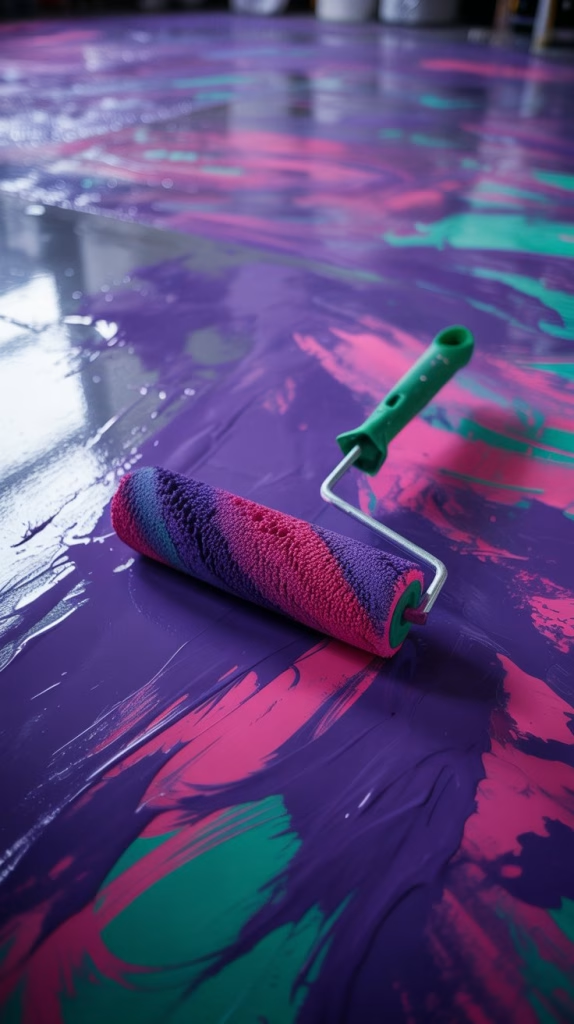
For the artist at heart, an abstract or swirled pattern offers the ultimate freedom of expression. This look is typically achieved with a multi-colored epoxy or polyaspartic system where different colors are poured and manipulated to create a marbled or swirling effect. The process is similar to a metallic epoxy installation but uses a wider range of solid and sometimes pearlescent pigments to create a more vibrant, high-contrast look.
This type of floor is a bold choice, and its success relies on a skilled installer who can control the flow of the pigments to create a cohesive and visually pleasing design. The result is a floor that is truly a piece of art, a floor that tells a story and injects an unparalleled level of personality into your garage. It’s a perfect choice for a garage that is used as a creative studio, a man cave, or simply a space where you want to be inspired.

